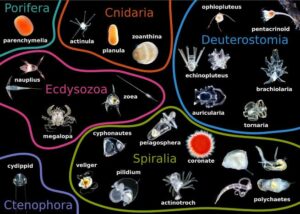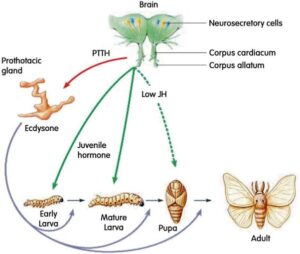Back to: ZOOLOGY 200 Level
WELCOME TO CLASS
Let’s talk about something fascinating today—larval forms. Have you ever wondered how a small, soft creature like a caterpillar becomes a butterfly, or how a mosquito begins life in stagnant water? These early life stages are known as larvae, and they play a very important role in the development of many invertebrates. Let’s find out more about them!
Larval Forms
What is a larva?
A larva (plural: larvae) is the immature stage of an animal that looks completely different from the adult. It usually hatches from the egg and undergoes several changes before becoming an adult through a process called metamorphosis. Larvae help the animal grow, feed, and adapt to different environments before reaching adulthood.

Different types of larval forms
In the animal kingdom, especially among invertebrates, there are many types of larvae. Let’s look at a few important ones:
Nauplius – This is the first larval stage of crustaceans like shrimps and barnacles. It has three pairs of appendages and a simple eye. It swims freely and feeds on plankton.
Trochophore – Found in animals like molluscs and annelids, this larva is shaped like a spinning top and uses tiny hair-like structures (cilia) to move and feed.
Planula – This is the free-swimming larva of cnidarians such as jellyfish and corals. It is oval-shaped and covered with cilia, allowing it to move in water until it finds a surface to settle and grow.
Caterpillar – The well-known larva of butterflies and moths. It feeds heavily on leaves before transforming into a pupa and finally becoming an adult butterfly.
Mosquito larva (wriggler) – Found in stagnant water, this larva lives and breathes through tubes that reach the water surface. It later transforms into a pupa before becoming an adult mosquito.

Why larvae are important
Larval stages help animals to survive in different environments from their adults. This reduces competition for food between young and adult forms. Also, larvae often serve as food for other animals like fish, birds, and amphibians, playing a vital role in food chains. In some marine species, larvae help with dispersal—spreading the species over wide areas by swimming with ocean currents.
Summary
- A larva is an early, immature stage of an animal that is different from the adult.
- Nauplius, trochophore, planula, caterpillar, and mosquito larvae are common examples.
- Larvae move, feed, and grow before changing into adult forms through metamorphosis.
- They help reduce food competition, support ecosystems, and aid in species distribution.
Evaluation
- What is metamorphosis?
- Mention two examples of larval forms and the animals they belong to.
- Why are larval stages important in the life cycle of invertebrates?
- How does a mosquito larva survive in stagnant water?
Your understanding of life cycles is growing stronger every day. Keep learning, keep shining, and remember—Afrilearn is here to guide you every step of the way. Ready for your next topic? Let’s keep going!
